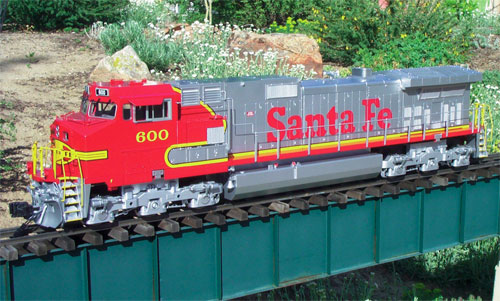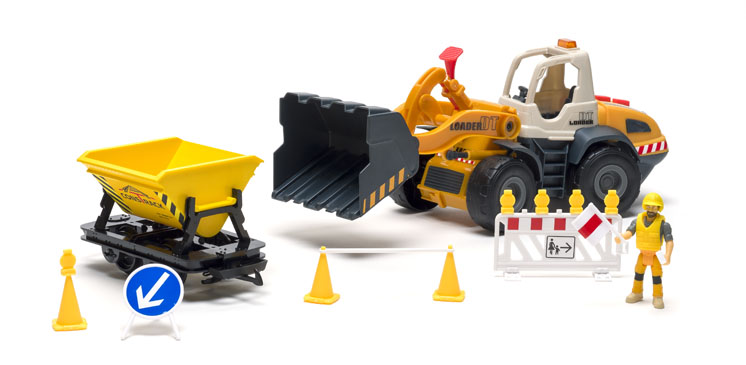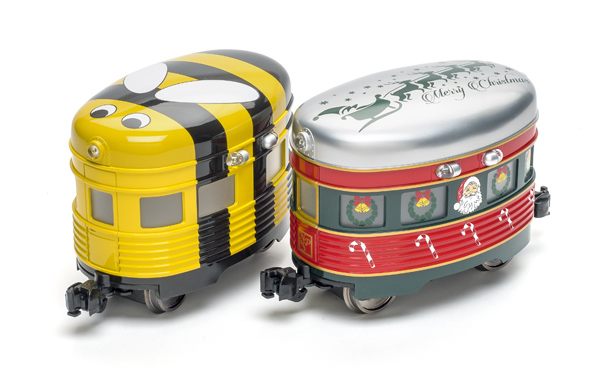1:29 scale, gauge 1, ready-to-run Dash 9 diesel
Aristo-Craft Trains
698 S. 21st St.
Irvington NJ 07111
Price: $380 (UP, BNSF, SF, $400)
Web site: www.aristocraft.com
Mostly plastic model of a Dash 9-44CW diesel locomotive; modular electrical connections and car body; two, three-axle power trucks with ball bearings; two motors per truck; bright-white LED directional front and rear head and ditch lights; lighted number boards; interior cab lighting and details; lighted porch and steps; operating smoke unit; metal railings and lift rings; operating knuckle couplers; opening side windows; prototypical graphics and road numbers. Dimensions: Overall length (sans couplers) 30″; width, 41/16″; height, 611/16″. In 1:29 scale this works out to 72’6″ x 9’10” x 16’2″, respectively.
Pros: Accurate reproduction of GE Dash 9 (post 2000); high level of detail; excellent paint and graphics; superb lighting system with operating ditch lights (LEDs used in headlights and ditch
lights); exceptional drive system with prototypical speed ranges
Cons: Silver painted, truck-mounted A-frames detract from appearance; painting error on Santa Fe version; model doesn’t match all prototype versions
Aristo-Craft’s model represents the latest variant of the Dash-9 locomotive. It most closely represents one of the most recent orders for Norfolk Southern’s Dash 9-40CWs. Other than the “gull wing” cab for the Santa Fe and BNSF models, the Aristo-Craft Dash 9 differs in appearance from the NS Dash 9s by having the front headlight mounted in the nose of the cab. NS Dash 9s have the headlight located above the windshield, between the number boards. They also have ditch lights on both ends of the unit.
The model reviewed here is decorated for Santa Fe in the famous “Super Fleet Warbonnet” scheme of red and silver, with yellow-and-black striping. The finish on this model is among the best I’ve seen on a model in any scale. The only error in my model’s paint scheme is on the raised walkway behind the operator’s cab, right side. This area is painted silver when it should be red. The separation between colors is quite sharp, the lines of the Warbonnet are precise and accurate, and the graphics are as opaque and evenly applied as the paint.
One thing I don’t like in regard to the paint is the treatment of the A-frame, which is designed to allow the truck sideframes to be applied to the motor blocks. The Santa Fe and BNSF versions of the model have these painted silver to match the trucks, which gives an otherwise-great model a toy-like appearance. This can be easily remedied by painting this piece flat black.
Every detail of the prototype is faithfully rendered in the model. The roof has the proper look for the dimpled anti-skid area. The windshield, cab nose, and roof slopes all accurately emulate the prototype. Side windows operate and the lighted cab interior has the proper desktop-style control stand. All the appropriate grab irons are accurately portrayed and the windshields have nicely rendered wipers. A separate bag includes detail parts to be added by the owner, including cab sunshades, three antennas (two large, one small), and cab wind deflectors. Holes are molded into the cab’s sides and roof to allow for press-fitting of these parts. The sunshades that came with my model appeared to have a slight warp to them where they attach to the cab, which caused one of the sunshades to repeatedly pop off. I applied a thin bead of a tacky adhesive to the edge of the shade’s attachment surface to secure it to the cab.
The model’s carbody is right on target and has some of this model’s best detailing. The dynamic brake has an intake port on the right side of the hood and an exhaust outlet port on the left. The intake port is marvelously done in multiple layers, featuring items such as the baffles beneath the metal mesh screening. The exhaust port on the left has the proper configuration of vents and U-frames around the port outlets. The air-conditioning unit rests on the raised walkway just beneath the dynamic-brake exhaust ports, and is a style of one of many variants used on prototype Dash 8s and 9s. All roof hatches for this phase of Dash 9 are properly done, including delicately molded lift rings, and all items are accurately arranged. The sides of the hood include the proper raised X-panels and heavy-duty lifting lugs. All the hood doors are of accurate style and arrangement.
Center roof section on the model can be removed to allow access to the various power switches that control the model’s functions. These are on/off switches for lights, smoke unit, and motor. There is also a switch for track or battery power. The back area in this section houses the smoke unit, which is the same as used on Aristo-Craft’s SD45. The control panel is the same, as well. This unit includes an automatic shutoff feature, should the unit run out of smoke fluid. The horn array is a beautiful brass casting.
The radiators are housed on the top, inside the distinctive “winged awning.” Again, various mesh screens and grills adorn the area, lending a remarkable effect.
The deck frame of the model is a one-piece molding with anti-skid dimpling on all the walkway surfaces. There are operating walkway lights at both ends of the model and one on each side. The walkway has anti-climbers at both ends, reflecting the current production units. The steps at each end of the model are see-through and the bottom steps have working step lights.
Pilot faces are adorned with air hoses and MU hoses. They also include the correct style of coupler cut bars and have MU receptacles and bracket details. The front pilot has a plow with open MU doors and hand grabs applied to the top edge. The plow is correct for many, but not all, Dash 9s. Working ditch lights are applied to the front anti-climber. Aristo-Craft knuckle couplers and “plug and play” connectors are also installed.
The fuel tank and underframe detail contribute to the model’s realistic look. The fuel tank has gauges and air tanks with piping. The fuel tank allows for additional weight to be installed by the owner and the underframe comes equipped with a speaker for an after-market sound system.
In general, the model’s version of GE’s Hi-Ad truck is beautifully done and portrays the most common version in use with the cantilevered struts. The wheels are Aristo-Craft’s now-standard version. The truck sideframe assembly encloses the motor block, or “brick.” Each block contains two low-draw motors for power with all-wheel drive. There are three gearbox drives attached to the motors in each power block. Each gearbox drive contains an axle assembly, and the worm gear on each axle has ball-bearing assemblies on each end. There is a slight bit of lateral play in each axle to allow the truck to travel through curves of as little as 4′ radius without actually having to articulate the truck.
I was impressed by how the model ran straight out of the box. The more I ran it, the better it performed. At the time I tested it for amp and voltage draw, it had about 20 hours of run time on it. At that time the model registered just a whisker under 3 volts starting power. At 3.5 volts and 2.25 amps the model ran without stall or hesitation at about 1.5 scale miles an hour. Maximum speed was near 20 volts with 3.25 amps. This worked out to be roughly 60 scale miles an hour. Drawbar pull at full load was 86 ounces, or about 70 average freight cars.
An auto-resetting fuse protects the model’s electrical system. In the event of a short circuit or overheating, the fuse will trip and shut down the locomotive. After a few moments it will reset and the engine will be ready to power up again. The model operates superbly in all its speed ranges.
This model is a joy to operate and observe running. At night, the engine lighting system is awesome. As the locomotive approached me from my observation point, the glare from the headlights and ditch lights was incredible. I even found myself squinting a bit as I gazed into the lights.
I also operated the Dash 9 with my Aristo-Craft SD45, and the two were evenly matched for MU operation. I especially appreciated being able to turn off the lights in the locomotive being used as a trailing unit.
Just as the GE Dash 9 is the embodiment of brute strength, the same can be said for Aristo-Craft’s model. It is one heavy hauler and faithfully replicates the prototype, both in appearance and operation.














